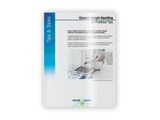To use all functions of this page, please activate cookies in your browser.
my.bionity.com
With an accout for my.bionity.com you can always see everything at a glance – and you can configure your own website and individual newsletter.
- My watch list
- My saved searches
- My saved topics
- My newsletter
Mutation
In biology, mutations are changes to the base pair sequence of the genetic material of an organism. Mutations can be caused by copying errors in the genetic material during cell division, by exposure to ultraviolet or ionizing radiation, chemical mutagens, or viruses, or can occur deliberately under cellular control during processes such as hypermutation. In multicellular organisms, mutations can be subdivided into germ line mutations, which can be passed on to descendants, and somatic mutations, which cannot be transmitted to descendants in animals. Plants sometimes can transmit somatic mutations to their descendants asexually or sexually (in case when flower buds develop in somatically mutated part of plant). A new mutation that was not inherited from either parent is called a de novo mutation. Mutations create variations in the gene pool, and the less favorable (or deleterious) mutations are reduced in frequency in the gene pool by natural selection, while more favorable (beneficial or advantageous) mutations tend to accumulate, resulting in evolutionary change. For example, a butterfly may produce offspring with a new mutation. Many times new mutations are harmful; a new mutation might change the color of one of the butterfly's offspring, making it harder (or easier) for predators to see. If this color change is an advantage, the chances of this butterfly surviving and producing its own offspring are a little better, and over time the number of butterflies with this mutation may form a larger percentage of the population. Neutral mutations are defined as mutations whose effects do not influence the fitness of either the species or the individuals who make up the species. These can accumulate over time due to genetic drift. The overwhelming majority of mutations have no significant effect, since DNA repair is able to mend most changes before they become permanent mutations, and many organisms have mechanisms for eliminating otherwise permanently mutated somatic cells. Additional recommended knowledge
ClassificationBy effect on structureThe sequence of a gene can be altered in a number of ways. Gene mutations have varying effects on health depending on where they occur and whether they alter the function of essential proteins. Structurally, mutations can be classified as:
By effect on function
By aspect of phenotype affected
By inheritanceThe human genome contains two copies of each gene- a paternal and a maternal allele.
Special classes
Causes of mutationTwo classes of mutations are spontaneous mutations (molecular decay) and induced mutations caused by mutagens. Spontaneous mutations on the molecular level include:
Induced mutations on the molecular level can be caused by:
DNA has so-called hotspots, where mutations occur up to 100 times more frequently than the normal mutation rate. A hotspot can be at an unusual base, e.g., 5-methylcytosine. Mutation rates also vary across species. Evolutionary biologists have theorized that higher mutation rates are beneficial in some situations, because they allow organisms to evolve and therefore adapt more quickly to their environments. For example, repeated exposure of bacteria to antibiotics, and selection of resistant mutants, can result in the selection of bacteria that have a much higher mutation rate than the original population (mutator strains). NomenclatureNomenclature of mutations specify the type of mutation and base or amino acid changes.
Types of mutationsAdaptive mutationIn mainstream biological thought it is held that while mutagenesis is non-random in many ways, the utility of a genetic mutation to the organism in which it occurs does not affect the rate at which it occurs. However experimental evidence exists that in some instances the rate of specific mutations arising is greater when they are advantageous to the organism than when they are not. Back mutationBack mutation is a change in a nucleotide pair of a point-mutated DNA sequence that restores the original sequence and hence the original phenotype.[4] Frameshift mutationA frameshift mutation is a mutation caused by indels, ie. inserts or deletes a number of nucleotides that is not evenly divisible by three from a DNA sequence. Due to the triplet nature of gene expression by codons, the insertion or deletion can disrupt the reading frame, or the grouping of the codons, resulting in a completely different translation from the original. The earlier in the sequence the deletion or insertion occurs, the more altered the protein produced is. Missense mutationMissense mutations or nonsynonymous mutations are types of point mutations where a single nucleotide is changed to cause substitution of a different amino acid. This in turn can render the resulting protein nonfunctional. Such mutations are responsible for diseases such as Epidermolysis bullosa, sickle-cell disease, and SOD1 mediated ALS(Boillée 2006, p. 39). Neutral mutationA neutral mutation is a mutation that occurs in an amino acid codon (presumably within an mRNA molecule) which results in the use of a different, but chemically similar, amino acid. This is similar to a silent mutation, where a codon mutation may encode the same amino acid (see Wobble Hypothesis); for example, a change from AUU to AUC will still encode leucine, so no discernable change occurs (a silent mutation). Nonsense mutationA nonsense mutation is a frameshift mutation in a sequence of DNA that results in a premature stop codon, or a nonsense codon in the transcribed mRNA, and possibly a truncated, and often nonfunctional protein product. Point mutationA point mutation, or substitution, is a type of mutation that causes the replacement of a single base nucleotide with another nucleotide. Often the term point mutation also includes insertions or deletions of a single base pair (which have more of an adverse effect on the synthesized protein due to nucleotides still being read in triplets, but in different frames- a mutation called a frameshift mutation). Silent mutationSilent mutations are DNA mutations that do not result in a change to the amino acid sequence of a protein. They may occur in a non-coding region (outside of a gene or within an intron), or they may occur within an exon in a manner that does not alter the final amino acid sequence. The phrase silent mutation is often used interchangeably with the phrase synonymous mutation; however, synonymous mutations are a subcategory of the former, occurring only within exons. Harmful mutationsChanges in DNA caused by mutation can cause errors in protein sequence, creating partially or completely non-functional proteins. To function correctly, each cell depends on thousands of proteins to function in the right places at the right times. When a mutation alters a protein that plays a critical role in the body, a medical condition can result. A condition caused by mutations in one or more genes is called a genetic disorder. However, only a small percentage of mutations cause genetic disorders; most have no impact on health. For example, some mutations alter a gene's DNA base sequence but don’t change the function of the protein made by the gene. If a mutation is present in a germ cell, it can give rise to offspring that carries the mutation in all of its cells. This is the case in hereditary diseases. On the other hand, a mutation can occur in a somatic cell of an organism. Such mutations will be present in all descendants of this cell, and certain mutations can cause the cell to become malignant, and thus cause cancer[5]. Often, gene mutations that could cause a genetic disorder are repaired by the DNA repair system of the cell. Each cell has a number of pathways through which enzymes recognize and repair mistakes in DNA. Because DNA can be damaged or mutated in many ways, the process of DNA repair is an important way in which the body protects itself from disease. Beneficial mutationsA very small percentage of all mutations actually have a positive effect. These mutations lead to new versions of proteins that help an organism and its future generations better adapt to changes in their environment. For example, a specific 32 base pair deletion in human CCR5 (CCR5-Δ32) confers HIV resistance to homozygotes and delays AIDS onset in heterozygotes.[6] The CCR5 mutation is more common in those of European descent. One theory for the etiology of the relatively high frequency of CCR5-Δ32 in the European population is that it conferred resistance to the bubonic plague in mid-14th century Europe. People who had this mutation were able to survive infection thus its frequency in the population increased.[7] It could also explain why this mutation is not found in Africa where the bubonic plague never reached. Newer theory says the selective pressure on the CCR5 Delta 32 mutation has been caused by smallpox instead of bubonic plague.[8] See alsoReferences
Online books
Categories: Evolutionary biology | Genetics | Mutation | Radiation health effects |
|||||||||||
| This article is licensed under the GNU Free Documentation License. It uses material from the Wikipedia article "Mutation". A list of authors is available in Wikipedia. |
- How does your computer smell? - Researchers create a highly sensitive biohybrid olfactory sensor
- High-throughput computational microscopy imaging - A new approach for high-throughput quantitative phase microscopy shows potential for delineating subcellular structures in large-scale cell studies
- Gaia_hypothesis
- Memory
- Lumbar_puncture







